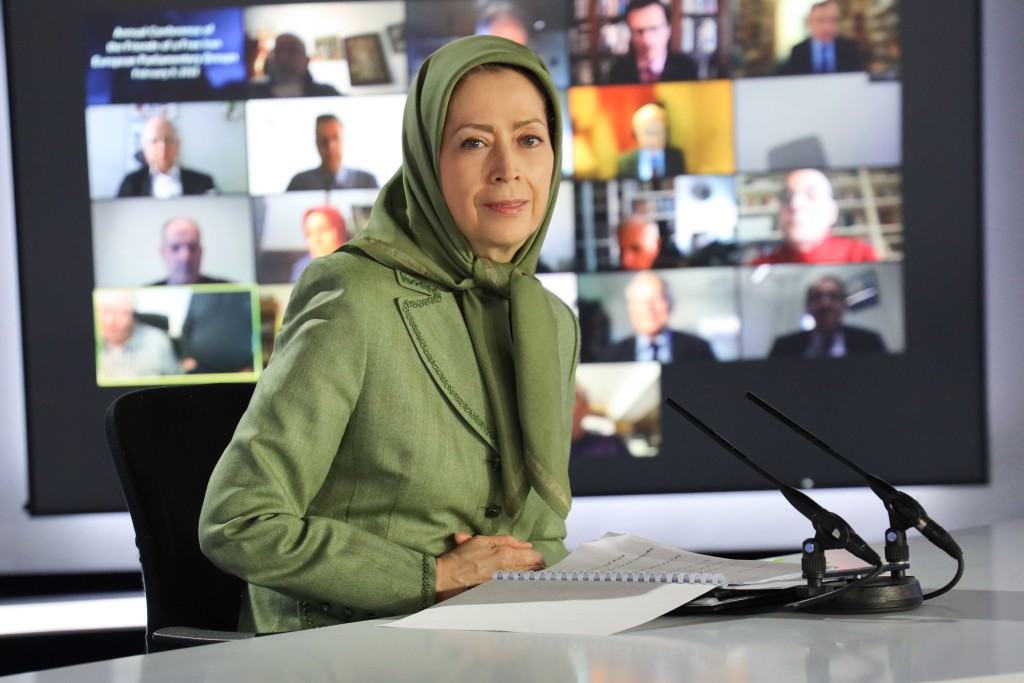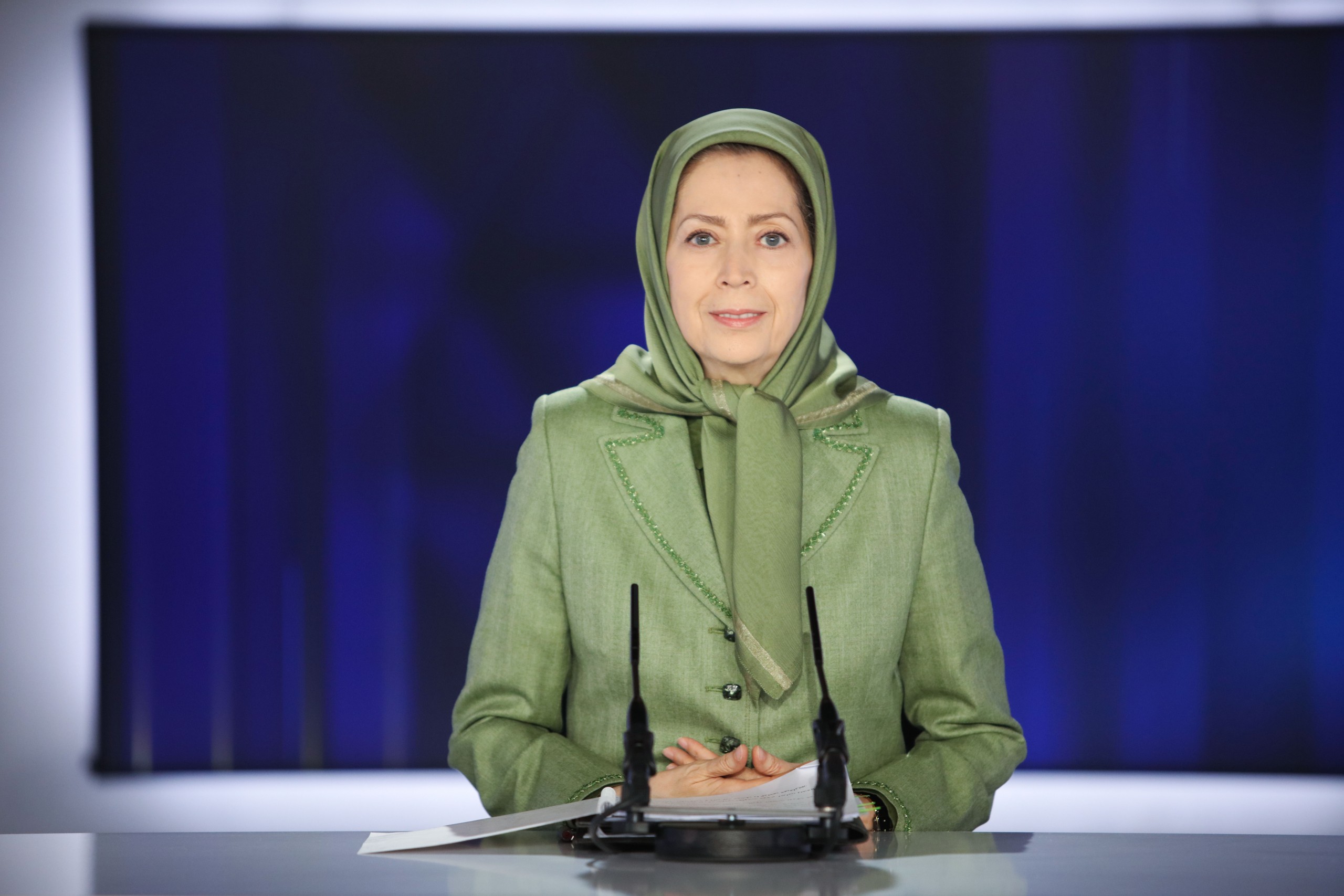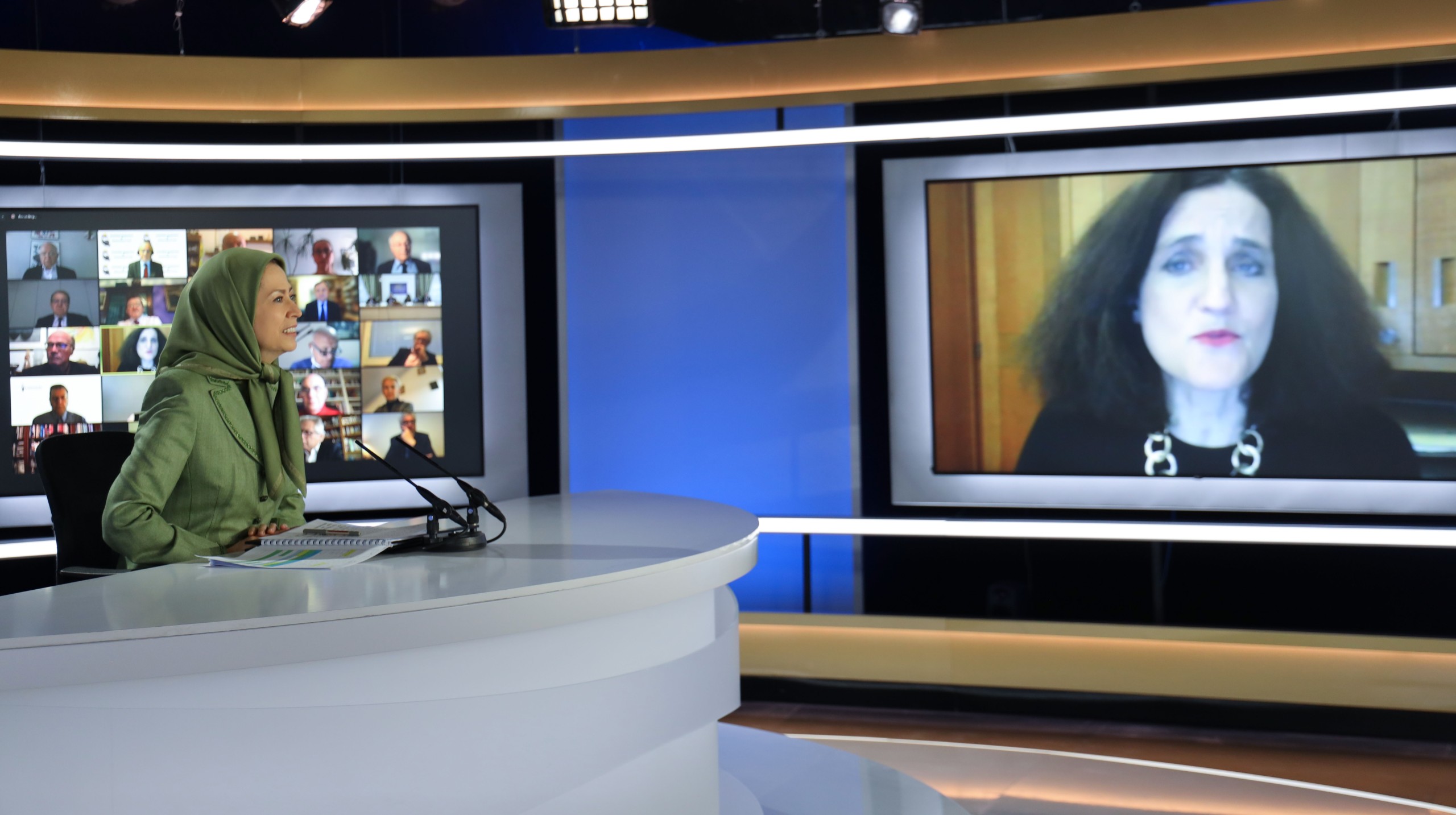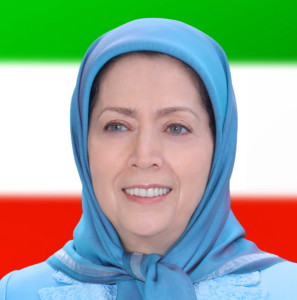Annual Conference of the Friends of a Free Iran European Parliamentary Groups – February 9, 2022

Maryam Rajavi: Just as they deposed the Shah’s dictatorship, today the people of Iran chant: Death to the oppressor, whether it be the Shah or the supreme leader
I greet you all, the honorable lawmakers and dear friends of the Iranian people and Resistance,
I especially greet the members of the parliamentary committees for a free Iran from Britain, Germany, France, Italy, Switzerland, the Nordic countries, the Netherlands, Romania, as well as the committee members in the European Parliament.
Thank you very much for attending the conference, which coincides with the anniversary of the Iranian people’s great revolution.
Today, an extraordinary situation exists concerning Iran both inside the country and abroad with respect to policies and developments in the Middle East and the rest of the world.
The situation puts a number of very important tasks on the table that need to be addressed.
Last year, Ali Khamenei, the regime’s supreme leader, paid a high price and appointed an executioner of the 1988 massacre as president. The appointment was his most important card in the wake of successive nationwide uprisings in Iran. Now the question is whether the new political arrangement can restore the mullahs’ battered power, and bring it future of stability and strength. Or conversely, has this new arrangement exacerbated the regime’s weakness and instability?
Numerous facts and evidence leave no doubt that the mullahs’ regime is in a state of being overthrown.
But is this assessment of the regime’s terminal phase rooted in the Iranian Resistance’s aspirations and goals?
The answer is no. This is not the specific view of the Iranian Resistance, nor is it something we have developed based on our struggle’s needs.
The realities of Iranian society point to the regime’s overthrow. In the past year, there has been a massive uprising in Iran every four months. Throughout the year, as the Iranian people were suffering from the spread of different variants of the Coronavirus and despite half-a-million deaths, the whole country has been gripped by protests and strikes.
The most important feature of these protests is that the regime cannot guess when the next protests will start. The IRGC and other security and intelligence services are constantly on alert and the constant tension is eroding their forces. If they delay in dealing with the protests, they will lose control of the whole situation.
Today, most of the contradictions in Iranian society have been activated acutely and sometimes irreversibly against the regime. Teachers and educators have staged numerous protests and demonstrations. Workers and farmers have revolted. In areas inhabited by Baluch, Arab and Kurdish compatriots, young people have repeatedly carried out armed attacks against the IRGC. In the impoverished slums, people are in constant skirmishes with the regime. The IRGC keeps destroying their homes, and in return, they are acting against the regime’s oppressive restrictions and laws.
The regime feels powerless in the face of this situation, primarily because it is facing a hostile society. People are openly shouting in the streets, “Our enemy is right here, it’s a lie when they says it is America.” The Iranian people’s deep-seated animosity toward the clerical regime is the main cause of its instability.
I must also point out that Khamenei has tested all possible ways to prevent the regime from reaching such a precarious state, in the context of maintaining his hegemony. But he has found no way out.
One of these ways was using the so-called reformist faction. The mullahs and the factions that pretended to be moderate or reformist acted for many years as an insulator to prevent the regime’s overthrow. After the outbreak of the uprisings in December 2017, Khamenei removed them from all state positions since their political effectiveness expired.
Another way was for the regime to reach a nuclear deal with the P5+1. The JCPOA met the mullahs’ political and financial needs through unjustified concessions. However, the regime never gave up the project of acquiring an atomic bomb because it needs one to maintain its rotten survival. Giving up the bomb will violate all the requirements for its security.
The uprisings that have swept Iran since December 2017 prove that despite the illusions fabricated and spread by the mullahs, the regime has no popularity among the poor and needy. To the contrary, the cities’ poor neighborhoods have turned into hotbeds of unrest and protests against the mullahs.
As I mentioned, having tested various ways but failing to break out of his deadlock, Khamenei was left with only one option in Iran’s political chess game. That option was the appointment of a hated mullah widely known as an executioner of the 1988 massacre. He has learned nothing but to hang Iran’s youths.
What does it mean when an executioner takes office?
First, it means that the wobbly regime is so politically unstable that it cannot even allow its most loyal figureheads to run in the sham presidential election. One of them was Ali Larijani who presided over the mullahs’ parliament for 12 years. Khamenei fears that in any future political turmoil, such men would open a deadly rift at the top. To the contrary, Raisi who was involved in the massacre of 30,000 PMOI and other resistant political prisoners will completely serve the mullahs’ supreme leader.
Secondly, it means that the clerical regime has blocked all the roads to any change or reform, both politically and economically. They know that they have no options but to escalate repression, incite wars, support terrorism, and continue their nuclear and missile programs.
In a word, Raisi benefits Khamenei in two ways; first – preventing more uprisings, and second, giving him an open hand in his nuclear project and foreign policy.
Therefore, Raisi is the most conspicuous indicator for the regime’s imminent overthrow.
The special feature of this era is that regardless of the fact that the regime abandons or keeps its nuclear program, it will face an outbreak of uprisings where the PMOI/MEK and its Resistance Units will play their leading role.
Khamenei thought that by establishing a monolithic regime and by giving full support to the murderous Raisi, he could at least take control of the regime’s miserable situation. Today, six months into his presidency, Raisi is heading the regime’s most desperate government in four decades.
The fraught economic situation under Rouhani has intensified during this period. For example, the budget deficit is 50%; the economic growth this year is below zero as in previous years; the inflation rate has reached between 50 to 60%. Poverty is rampant and much of the middle class is impoverished. At least 40 million of the country’s 85-million strong population are living below the absolute poverty line.
The regime’s policies have destroyed the country’s environmental resources. Most of the wetlands have dried up; vast parts of many provinces are dehydrated or experiencing water crises; deforestation is on the rise; and Iran‘s cities are among the most polluted cities of the world.
These ruins are, in fact, the result of the regime’s failures in political, economic, and social fields. Yes, the mullahs have reached the end in every respect.
Grassroots social support for the Resistance
Dear Friends,
The Iranian Resistance has been standing up to the religious dictatorship for the past 43 years.
Mohammad Khatami, a former president of the regime, described this Resistance as the hugest tide and the most formidable storm. Mahmoud Ahmadinejad, another former regime president, said the Resistance was sufficient to topple several regimes. Without this Resistance, religious fundamentalism would have dominated the Middle East.
The clerical regime sees an existential threat in the PMOI/MEK and the Iranian Resistance, so confronting this threat is one of their top priorities in foreign policy, security, public relations, and psychological warfare.
Ali Akbar Velayati, the regime’s former foreign minister, once told European ambassadors that they had to choose between friendly relations with the regime and supporting the PMOI/MEK.
Kharrazi, his successor, also used to say that a significant yardstick in assessing the honesty of European countries was their relations with the PMOI/MEK.
A few days ago, the state media in Iran announced that in his latest telephone conversation with the French President, Raisi explicitly demanded the expulsion of the PMOI/MEK from member states of the European Union.
When Rouhani was the regime’s president, he called the French president, just a day after the uprisings in December 2017, and asked him to take action against the PMOI/MEK. At the time, the Figaro newspaper cited the Elyseé as saying, “We have never had any talks with the Iranians where they did not raise the issue of PMOI/MEK.”
Yes, there is a long history of that fact. One of the constant and incessant demands of the regime’s leaders and officials in their talks with the Western governments is to put pressure on the PMOI/MEK.
Dealing blows to the Iranian Resistance also serves as one of the regime’s constant terrorist ambitions. In Persian New Year (Nowruz) of 2018, two and a half months after the December 2017 uprising, the regime tried to blow up a truck full of explosives next to the residence of the Iranian Resistance‘s Nowruz ceremony. When the operation failed, it launched another terrorist attack. Under the command of a diplomat working in Austria, the clerical regime sought to set off a bomb at the NCRI annual rally in Villepinte, Paris, to inflict heavy casualties on the movement. The operation also failed and the diplomat in charge was arrested and later sentenced to 20 years in prison in Belgium.
Why, indeed, does the regime commit such criminal acts?
Because it constantly feels endangered by a Resistance movement and a democratic alternative that promotes the omnipresent dissatisfaction in society toward a purposeful struggle for the overthrow of the regime. But this threat has considerably intensified since the uprisings and the protest movement in Iran escalated. The network of PMOI forces, which is organized in most of the provinces, poses a real tangible threat to the mullahs’ rule. The mullahs’ Supreme Leader, Ali Khamenei, confessed to the PMOI’s role in his public speeches regarding both the uprisings of December 2017-January 2018, and November 2019.
The Resistance Units are part of the PMOI network in Iranian cities. They are engaged in a vast anti-repression campaign on a daily basis, preparing the people for forthcoming uprisings and showing them the true political direction. These activities are incessant and nationwide.
Recently, the regime plunged into panic over the abrupt cessation of the broadcast of dozens of its television and radio channels which suddenly carried the images and messages of the Iranian Resistance. The state media and spokesmen have repeatedly acknowledged that they feel threatened by the quality and complexity of the operation. The grassroots social support for the Iranian Resistance has shocked the regime.

The policy of appeasement
Many wonder why the Western media do not cover the widespread activities of the Resistance inside Iran.
The answer is clear: The Resistance Units’ activities reflect the reality of the great social struggle in Iran. The Western media ignore these activities because they continue to follow the appeasement policy of their foreign ministries. They hush the issues related to the PMOI/MEK to observe the mullahs’ main redline.
Unfortunately, a detested regime, which is globally recognized as the fountainhead of terrorism, and incitement to war and fundamentalism, enjoys enough leeway and facilities in Western countries to launch slander and disinformation campaigns against the PMOI/MEK in the Western press.
Many cases have already been exposed in which the regime paid large sums of money to some sellout journalists or writers to publish all sorts of unbelievable lies against the Mojahedin.
Really, why does the regime need to constantly spread slanders and fabricated stories against the Iranian Resistance? Why does it spend so much money on its demonization campaigns against the PMOI? And why are they knocking on every door to prevent a representative from attending the Iranian Resistance’s conferences?
Many of you have personally witnessed the regime’s activities in this regard.
The reason is that it wants to discredit and tarnish the image of its democratic alternative and make it look insignificant, thereby dispelling the big lie that there is no alternative in Iran. It wants to persuade the Western governments that they have no choice but to deal with this reactionary and repressive regime.
For more than three decades, the policy of Western governments has been to come to terms with religious fascism and give in to the mullahs’ blackmail. This policy has an astonishing history at the expense of the blood and suffering of the Iranian people and Resistance. Of course, the West itself has also paid a heavy strategic price for its mistake.
For example, two decades ago, the Iranian Resistance exposed the regime’s secret nuclear sites in Natanz and Arak. Instead of showing decisiveness and forcing the regime to dismantle its nuclear program from the outset, Western governments gave the mullahs incentive packages. The most important incentive package, of course, was participating in the suppression of the Mojahedin (PMOI/MEK) and imposing restrictions on them.
It was also the Iranian Resistance that first exposed Islamic fundamentalism as a new global threat in the 1990s. But from the second half of this decade, the policy of designating the PMOI/MEK on terrorist lists began to suit the clerical regime’s demands. This was the biggest incentive to the regime, encouraging it in export of terrorism.
You certainly know that the Iranian Resistance was also the first party to expose the activities of the terrorist Quds Force. At a time when few people had even heard of this terrorist force, the PMOI/MEK published the list of more than 30,000 of its mercenaries and wage earners in Iraq. Instead of eradicating the regime’s proxies, the United States handed over the protection of the city of Ashraf to Khamenei’s puppet government in Iraq.
Moreover, Western governments have remained silent throughout the past three decades on the massacre of 30,000 political prisoners in Iran that is the worst unpunished crime against humanity since World War II.
Unfortunately, these policies are not limited to previous years, but continue in other forms.
Everyone is aware of the trial of a terrorist diplomat of the regime and three other mercenaries of the Ministry of Intelligence for participating in a terrorist plot against the Iranian Resistance’s rally in Villepinte, Paris. The regime’s terrorist who carried the bomb was a working diplomat and was sentenced to 20 years in prison, an unprecedented development in the world today. The court’s ruling provided an excellent opportunity for European governments to round up and deport the Iranian regime mercenaries and dormant terrorist cells from Europe. It was also a significant opportunity to close the regime’s embassies, which according to annual reports by German and Dutch security services are centers of espionage. However, inaction was what happened on the part of the West.
Indeed, are the IRGC proxy groups not attacking the UAE, Saudi Arabia or Iraq today in front of the eyes of the whole world? So why is the IRGC not included in the list of terrorist groups in the European Union and various European countries?
Is Europe not threatened by the regime’s terrorism? And is it not true that Tehran’s missile program can now target parts of Europe? The UN nuclear watchdog has repeatedly reported that the Iranian regime has violated most of the provisions and redlines of the JCPOA. So why does the Security Council not declare the clerical regime as the main threat to world peace and security? Why are the six UNSC resolutions, repealed in 2015, not reinstated against the regime? And hundreds of other questions…
The Iranian Resistance’s call on the international community
Dear friends,
The Iranian Resistance calls on the international community, especially Western governments, to adopt policies that, in the current critical situation, are the inevitable responsibility of these governments. Policies that are in line with democracy and sovereignty of the Iranian people and serve peace and tranquility in Europe and the Middle East.
The Iranian regime is the foremost state sponsor of terrorism and fundamentalism, which also carries out the largest number of executions. So it must be held accountable for its crimes.
The deafening silence and extreme inaction of Western governments in the face of all these crimes must end.
The IRGC and the Ministry of Intelligence must be placed on the list of terrorist groups, and their mercenaries and agents expelled from Europe. Their passports and citizenships must be revoked just as was done in the cases of the terrorists and mercenaries convicted in the Court of Belgium.
Parliaments around the world and governments must register and condemn the 1988 massacre as “genocide” and “a crime against humanity.”
And they should recognize the Iranian people’s struggle to overthrow the mullahs’ regime and to establish democracy and people’s sovereignty.

The anniversary of the anti-monarchical revolution
Dear friends, fellow compatriots,
On the anniversary of the anti-monarchical revolution, we pay tribute to all the martyrs, the wounded and all the battles, uprisings, sufferings, and sacrifices that led that great revolution to victory. We send our greetings to the selfless revolutionaries and the true leaders of the 1979 Revolution.
The slain heroes, Mohammad Hanifnejad, Saeed Mohsen, Asghar Badizadegan, Massoud Ahmadzadeh, Amir Parviz Pouyan, Bijan Jazani, Shokrollah Pakenjad, Fatemeh Amini, Marzieh Ahmadi Oskouii, Azam Rouhi Ahangaran, and the Ayatollah Taleghani who symbolized the true spirit of the anti-monarchical revolution. Also Ashraf Rajavi and Moussa Khiabani, the honorable martyrs of February 8, 1982.
The PMOI and the Fada’ii guerrillas were the ones who first promoted the idea of overthrowing the Shah’s dictatorship. Then they turned it into the Iranian people’s main aspiration through their brave battles, staunch resistance in the SAVAK torture chambers, and sacrifice of their lives before the firing squads.
Khomeini and his savage companions, who plundered the fruits of the Iranian people’s struggle and hijacked the leadership of the anti-monarchical revolution, did not have the slightest alliance with the democratic ideals of the people who had risen up against the Shah.
For years, Khomeini had sought safety by remaining in his house in Najaf, Iraq. He opposed the revolutionary movements of the 1970s. His maximum demand from the Shah was over the guardianship of the Ministry of Endowments. The Shah’s crackdown on national, democratic, and revolutionary movements paved the way for Khomeini. As Massoud Rajavi said, Khomeini was the Shah’s true crown prince.
As they have demonstrated since 1979, Khomeini and his successors have done nothing but plunder and pillage. They destroyed and looted the products of the nation’s suffering and sacrifices. They plundered and destroyed Iran’s national heritage, and ruined its culture, economy, environment and social relations.
The execution of 120,000 of Iran’s valiant children, including the massacre of 30,000 PMOI and other resistant political prisoners in 1988, is part of this catastrophic record.
But the Iranian Resistance, founded by Massoud Rajavi, has defended the value of freedom ever since the day Khomeini monopolized power. It launched successive movements to defend the honor and freedom of Iran and Iranians, trained countless generations of vanguards, and built a democratic alternative to religious tyranny.
The Iranian Resistance that has been struggling for the past 43 years is in fact the evolutionary continuation of the anti-monarchical revolution.
Just as they deposed the Shah’s dictatorship from ruling over their destiny, today the people of Iran chant: Death to the oppressor, whether it be the Shah or the supreme leader.
The Iranian people want an elected government based on the separation of religion and state, just as they seek respect for all political, social and individual freedoms.
They see this future in the democratic alternative to the clerical regime, the National Council of Resistance of Iran (NCRI).
An alternative founded by Massoud Rajavi with the demarcation of neither the Shah nor the Sheikh that has been advancing from the beginning mindful of this principle in every step and in every stage.
Those who claim that there is no alternative to the clerical regime are lying to placate the mullahs. They want the continued existence of the regime to pursue their own commercial ties with it.
Khomeini turned the “freedom-loving” aspirations of the 1979 protesters into a bloodbath.
But our Resistance movement is proud to have elevated that cry to the formation of a democratic alternative and a powerful movement which is able to fulfill the historical aspirations of the Iranian people.
We renew our pledge with all the leaders and martyrs of the 1979 Revolution. We underline the Iranian Resistance‘s devotion to establish freedom, democracy and equality in Iran, and to liberate the people of Iran from the oppression of the inhuman mullahs.
Hail to the people of Iran
Long live freedom
- Tags: Human Rights, Iran, Iran protests, Maryam Rajavi

